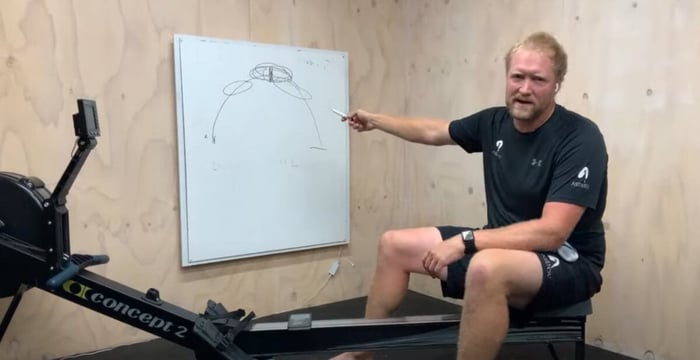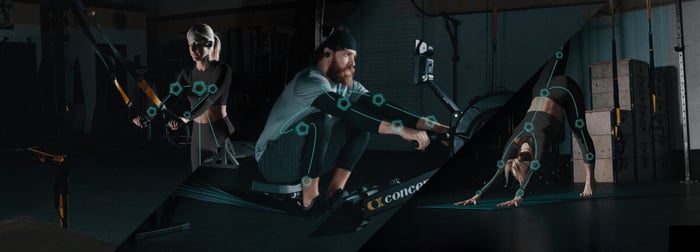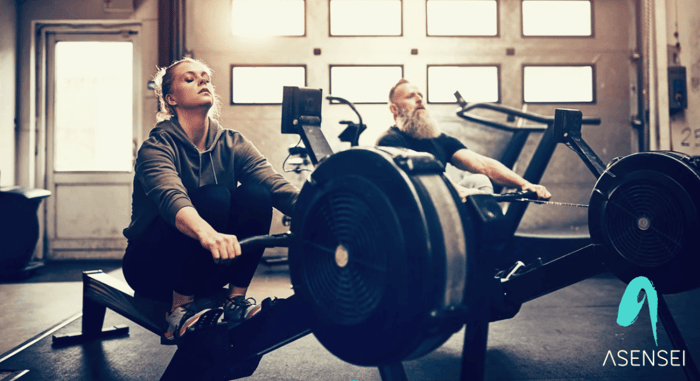A good warmup for rowing will get your heart pumping, exercise all major muscle groups, help your joints loosen up and as a result help prevent injury - but did you know that a great indoor rowing warmup can help you improve performance and perhaps even set you up to beat your personal best? In this article seven tips for the perfect indoor rowing warmup we learn how to use the warmup as a performance advantage and get the most out of your workout or race, whether it's 500m, 1000m, 2km, 5km, 6km or more!
Table of Contents
- Seven Tips for the Perfect Indoor Rowing Warmup
- 1. Tailor the warmup to your workout (or race)
- 2. Progression: start gradually and build
- 3. Find the Goldilocks zone - not too cold nor too hot!
- 4. Remember Technique when warming up
- 5. Don't leave too long between the warmup and the workout!
- 6. Optimize: learn what works for you
- 7. Add variety to your rowing warmup
- Conclusion
- Example Rowing Warmups
- DOWNLOAD ASENSEI TODAY
Seven Tips for the Perfect Indoor Rowing Warmup
The indoor rowing machine is always popular for a general warmup in gyms, because it exercises so many of the major muscle groups in the body (about 86%) making you ready for almost any exercise but many people don't know how to use it correctly. Read on to find out our top seven tips for the perfect indoor rowing warmup, featuring insights from double Olympic Champion Eric Murray and San Francisco studio indoor rowing coach Johan Quie.
1. Tailor the warmup to your workout (or race)
For best results don't just follow the same rowing warmup slavishly for every session. Matching your indoor rowing warmup to the upcoming training session or race will help you reach peak performance.
In the asensei Livestream video PERFECT WARMUP Olympic champion rower Eric Murray walks us through a warmup that can be adapted for many types of rowing race. The general structure of this session is to have 6-8 minutes of continuous steady state rowing to help you find rhythm followed by two sets of increasing stroke rate intervals separated by a short break, this will get your fast twitch muscles primed for your expected race pace.
If you are tackling race distances from 1000m to the classic 2000m rowing race distance or a timed test like 4 minutes then Eric suggests you should look to warmup using 6-8 minutes of steady rowing followed by 1 minute on, 1 minute off intervals that start about 24spm and ramp up to about 32-34spm, you'll ease off after the first set of intervals for about 90 seconds and then repeat them as a second set.
For a shorter sprint, up to 500m, or a 1 minute timed test you'll not need quite as long a warmup. You will still want something like a 6-8 minute continuous rowing base, but might then progress to shorter 30s on 30s off intervals and ramp up to higher stroke rates, similar to those you will expect in the race. So you might do 30s at each of 30->34->36->38 strokes per minute (spm).
For a longer session such as a 5k or a 6km race again you would vary the warmup by extending the steady state segment at the start, up to 10 minutes, then move onto intervals, again building up to the pace that you expect to peak at during your race, so perhaps 60 seconds to 90 second intervals, starting at 24spm to 26spm and maybe peaking at 30spm - because you are unlikely to be rating as highly as in a shorter race.
Another rowing tip is if you are doing a steady state workout such as a UT2 type session or a longer session like a marathon you may be able to get away with less intensity in the warmp and the same applies for a regular training session (as opposed to a test or race). In these scenarios you might want to focus more on the technical aspects of the rowing stroke to help you get into the groove and maintain good form throughout the session.
2. Progression: start gradually and build
Progression is your friend in a warmup for rowing. Because by definition you normally start off 'cold' it's wise to ease yourself in gradually, taking care not to over extend your muscles until you are ready. You'll generally want to start off at a low stroke rate and start with shorter, low pressure strokes, only reaching full extension over time and only then starting to think about building the intensity and effort you put into each stroke.
In fact sometimes warmup for rowing machine workouts start with a partial stroke, such as arms only, then gradually introduce arms and body, before progressing to the full arms-body-legs stroke. This not only helps ease you into the full stroke, but also helps you focus on correct technique. You can see an example of this approach in the (RE)COMMIT SHORT WARMUP in the asensei app.
In his race warmup livestream Eric takes about 90 seconds to get out to full length strokes at the start of that warmup. During that time you'll find that any tension in your body starts to ease off and then he gradually builds intensity and power during the initial steady state rowing period. He recommends staying 2-3 'splits' (that means reducing your 500m pace, or split time, by 2-3 seconds) below the training pace you would normally do for a 20spm steady state (UT2) session. And remember, always stay relaxed even as the intensity builds.
Shane Farmer's famous 10 minute build warmup is another favorite example of a warmup that builds to a peak, with the damper set to it's lowest setting you build from 16spm, cranking it up to 30spm over 10 minutes. Used in the BE A DARK HORSE rowing program it's a great way to warmup for your regular workouts.
3. Find the Goldilocks zone - not too cold nor too hot!
Most people just don't warm up enough for a row, especially before before an erg race or a high intensity workout. Olympic Champion rower Eric Murray's physiologist used to tell him that a 45 min warmup was what was needed to ensure that your body was fully awake, ready and firing on all cylinders. While that may be a bit extreme for most of us non-Olympic standard athletes, it does illustrate the benefit of making sure that you allow enough time for your body to prepare for the upcoming session. The danger of too short a warmup is firstly injury, but also missing your peak performance zone. In fact for common rowing race distances like 1000m, 2000m or a short 4 minute max distance test Eric actually recommends a warmup that is more like 20-30 minutes and you might vary that up or down a little depending upon the upcoming workout you're preparing for.
The flip side of the coin is much less common, but if you significantly overdo the warmup you might run the risk of tiredness, muscle fatigue and in the extreme even cramp during your session. For absolute peak performance there's a relatively narrow window which is why you will want to figure out what works best for you.
4. Remember Technique when warming up
What you do in the warmup will influence your workout or race. This applies to stroke rate and intensity as mentioned above, but don't forget about technique, remember good form is free speed!
For some workouts you might want to focus on a more technical warmup so that you get your technique in the Groove. Expert rowing coach Johan Quie has a SHORT TECHNICAL WARMUP that features a number of different drills such as the pick drill, and the half slide and his 14 minute JQ SIGNATURE WARMUP also combines drills with progression and is a great warmup for a medium duration session. This can be found in the asensei WARMUPS, COOLDOWNS, STRETCHES program.
5. Don't leave too long between the warmup and the workout!
Don't let yourself cool down too much after you complete the warmup or you will start to lose the full benefit.
If competing in an indoor rowing competition you'll want to carefully plan your warmup to begin an appropriate time before the start time so make sure you know how long your warmup takes. You should also factor in the time to walk to the rowing machine if competing in person so, don't start warming up too late. Time your warmup so it finishes around 5-10 minutes before the scheduled start, but if the schedule changes as it often does, don't panic, just keep moving gently and try and ensure that you are staying warm. If the gap between the end of your warmup and the start of the race is too long, don't be afraid to do a couple of more vigorous intervals to get going again - you shouldn't need a lot to maintain readiness without burning too much energy.
6. Optimize: learn what works for you
Articles and workouts can give advice but a constant refrain that you'll hear in our asensei coaching is to figure out what works best for you. To really hit peak performance it's important to learn how you can take coaching advice and adapt it for your body, your physiology and your style.
Learn to listen to your body. We don't all fit into the same box, but most of us are not too dissimilar. The differences you might pickup through experience and being in tune with your body might be small but they can help give you an edge.
For example, Eric Murray tells us he doesn't like to stretch until his muscles are warm from some gentle rowing while others may prefer to start with stretching and progress to rowing. If you are looking for some pre-workout stretches Johan Quie has some in his JQ DYNAMIC (OFF ERG) WARMUP in the asensei app.
7. Add variety to your rowing warmup
If there are training sessions you keep coming back to time after time, why not introduce some variety into the warmup to help keep things fresh and interesting. By experimenting you'll also get a better feel for what works for you, and what doesn't.
As well as the livestream PERFECT WARMUP session the majority of workouts in the asensei app feature appropriate warmups and we also offer a dedicated program called WARMUPS, COOLDOWNS, STRETCHES to allow you to choose your own warmup anytime if that's what you prefer. There are a range of sessions to choose from, coached by Shane Farmer of Dark Horse Rowing, Johan Quie and Eric Murray and the British Rowing coach Clare Holman has some great warmups in the MASTER THE BASICS program.
Watch the full PERFECT WARMUP session below, Eric gives a lot of insight into his recommended approach and you can row along and put it all into practice as it is a great workout too!
Recommit Plus W7S1 - Perfect Warmup
Eric Murray gives tips for the perfect indoor rowing warmup
Conclusion
If you are preparing to row a race, or a max distance test then a proper warmup is critical to achieving peak performance. Our tips for the perfect indoor rowing warmup will help you improve. The warmup you choose should be tailored for your circumstances - a faster row will need a different warmup to a longer distance or time session. You'll start gradually and build intensity during the warmup but it's also well worth experimenting a little so that you can find out what works for you in terms of duration and intensity, so that you hit the sweet spot when you start your race - adding some variety to the warmup can also help keep the sessions interesting. If you are mindful of technique during your rowing warmup that will help you maintain form while under pressure in the race itself.
To help you further we've created some examples to help get you started, these can be found below and include a great erg race warmup rowalong video from coach Eric Murray.
Example Rowing Warmups
We've summarised some example warmups below, but you can adapt any of these using the guidance in the article above to suit your precise circumstances.
Warmup for a 1000m or 2000m row, or a 4 min test
Example warmup for a 1000m, 2000m or 4 minute rowing race (or similar distance/time).
- 6-8 minutes of steady rowing, starting off light and gradually building intensity. This can be a good place to think about technique and you might throw in a few minutes of your favorite drill.
- Two sets of 1 minute on, 1 minute off intervals at 24-34spm with 90 seconds rest between sets. Each set looks like this:
- 1 min at 24spm, 1 min easy rowing
- 1 min at 26spm, 1 min easy rowing
- 1 min at 28spm, 1 min easy rowing
- 1 min at 30spm, 1 min easy rowing
- 1 min at 32spm, 1 min easy rowing
- 1 min at 34spm, 1 min easy rowing (you may choose to skip this final interval)
The video below contains an erg race warmup, featuring coach Eric Murray it's a great example of a 1000m rowing warmup to row along with and learn:
Warmup for a 500m or a 1 min row
Example warmup for a 500m or 1 minute rowing race (or similar distance/time).
- 6-8 minutes of steady rowing, starting off light and gradually building intensity. This can be a good place to think about technique and you might throw in a few minutes of your favorite drill.
- Two sets of 30 seconds on, 30 seconds off intervals at 30-38spm with 60 seconds rest between sets. Each set looks like this:
- 30 seconds at 30spm, 30 seconds easy rowing
- 30 seconds at 32spm, 30 seconds easy rowing
- 30 seconds at 34spm, 30 seconds easy rowing
- 30 seconds at 36spm, 30 seconds easy rowing
- 30 seconds at 38spm, 30 seconds easy rowing
Warmup for a 5km, 6km or 10km row
Example warmup for a 5000m, 6000m or 10,000m rowing race (or similar distance/time).
- 8-10 minutes of steady rowing, starting off light and gradually building intensity. This can be a good place to think about technique and you might throw in a few minutes of your favorite drill.
- Two sets of 60-90 seconds on, 1 minute off intervals at 24-30spm with 90 seconds rest between sets. Each set looks like this:
- 90 seconds at 24spm, 1 min easy rowing
- 90 seconds at 26spm, 1 min easy rowing
- 60 seconds at 28spm, 1 min easy rowing
- 60 seconds at 30spm, 1 min easy rowing
DOWNLOAD ASENSEI TODAY
We hope you enjoyed these rowing tips. Rowing is better in the asensei app. You will have all the key stats displayed on screen during your session, you will have asensei set you personalized goals, you won't need to program the machine or take note of your results, asensei does it all.
While most workouts in the app include a suitable warmup the app also includes a program of dedicated warmups that you can run independently of any workout if you prefer a different approach.
|
asensei is FREE to download and with no commitment you can trial the first 3 workouts in the (RE)COMMIT program and also workouts from MASTER THE BASICS, (RE)FOCUS, SWEAT FACTORY and BE A DARK HORSE. All you need is an iPhone and access to an asensei Compatible rowing machine from Concept 2, WaterRower or FluidRower with a bluetooth capable monitor. |





